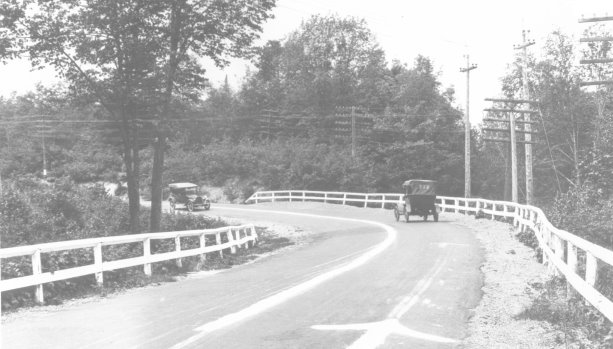Canadians are responsible for a number of cool inventions, among them Standard Time, Pablum, five-pin bowling, the Canadarm, insulin and the Robertson screwdriver. This article was supposed to be an account of another great Canadian invention — the painted longitudinal road line — but it isn’t.
I was initially inspired by a web page on the site of Library and Archives Canada that stated:
"Incredibly, there was no such thing as road lines before 1930. Before then, drivers sometimes stuck evergreen boughs into the snow to mark lanes and depended on horns and sleigh bells to warn oncoming traffic. In 1930, John D. Millar, an engineer working for the Ontario Department of Transport thought up the idea of painting lines on roads. The world’s first lines were painted on a portion of highway near the Ontario/Quebec border. This innovation caught on quickly and within three years white lines were a common standard throughout North America."
There’s photographic proof: an archival photo of a car accident is subtitled: "Automobile accident on a road without lines, 1929."
The account is repeated in the Canadian Encyclopedia and about a hundred other places.
Searching the archives of the Toronto Daily Star for news of this great invention proved disappointing.
An article appearing in the Oct. 5, 1928 issue of the Star reveals that painted road lines were already a going concern, shedding doubt on reports of the achievements of Mr. Millar. The newspaper reported a debate with rival newspaper The Telegram over whether pedestrians using streetcars on St. Clair Avenue would be better protected by white painted lines or the construction of raised platforms and metal posts. (The Star plan won out, although it took 80 years for those streetcar platforms to be built.)
I could buy the idea of drivers honking horns and jingling sleigh bells to warn oncoming vehicles. But thinking more critically, it now seemed unlikely that motorists would stop on roadsides in the dead of winter, then harvest evergreen branches to plant them in the snow on highway centre lines.
I finally struck research gold with a report by the Texas Transportation Institute: Evolution of the US Pavement Marking System written in the year 2000.
While the report indicates that longitudinal painted lines might have been used to separate lanes of traffic in Cincinnati as early as 1911, they were used widely in Michigan in subsequent years. A photo from the collection of the Michigan Department of Transportation reveals a sloppy but effective hand-painted centre line crudely bisecting the road along Dead Man’s Curve on the Marquette–Negaunee Road in Marquette County, Mich., circa 1917.
A final e-mail query to the Ministry of Transportation of Ontario (MTO) in support of a great Canadian invention provided the final disappointment.
"MTO has not made a historical claim on the idea of painting lines on the road," ministry spokesperson Ajay Woozageer wrote back. "There seem to be some factual inconsistencies in the article and we cannot confirm the involvement of John D. Millar, an engineer working for the Ontario Department of Transport in 1930 with painting road lines in Ontario at that time."
I can now state with a high degree of certainty that John D. Millar did not paint the world’s first longitudinal line down the centre of a highway. However, I can just as comfortably state that any line he did paint near the Ontario/Quebec border was superior to a series of evergreen branches, real or imagined.
Besides, Canadians can still claim we invented the world’s first highway numbering system, first used in Manitoba in 1920.
And the zipper.



Recent Comments
comments for this post are closed